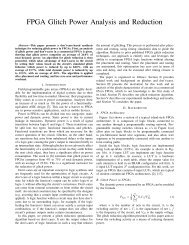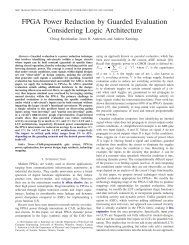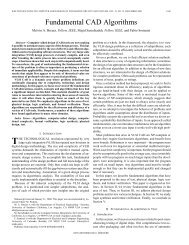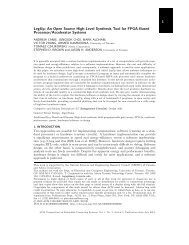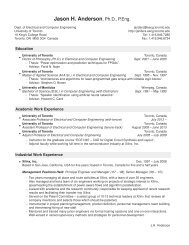- Page 5 and 6: AcknowledgmentsThroughout my life,
- Page 7 and 8: ContentsAcknowledgmentsList of Figu
- Page 10 and 11: Contentsx
- Page 13 and 14: List of Figures6.4 Finding the set
- Page 15 and 16: List of Tables2.1 Summary of commer
- Page 17 and 18: 1 Introduction1.1 Field-Programmabl
- Page 19 and 20: 1.2 MotivationDespite the relative
- Page 21: 1.3 Thesis Contributions(look-up-ta
- Page 25 and 26: 2 Background and Related Work2.1 In
- Page 27 and 28: 2.2 Power Dissipation in CMOS Circu
- Page 29 and 30: 2.2 Power Dissipation in CMOS Circu
- Page 31 and 32: 2.2 Power Dissipation in CMOS Circu
- Page 33 and 34: 2.2 Power Dissipation in CMOS Circu
- Page 35 and 36: 2.2 Power Dissipation in CMOS Circu
- Page 37 and 38: 2.3 FPGA Architecture and Hardware
- Page 39 and 40: 2.3 FPGA Architecture and Hardware
- Page 41 and 42: 2.3 FPGA Architecture and Hardware
- Page 43 and 44: 2.4 Power Dissipation in FPGAsLogic
- Page 45 and 46: 2.5 FPGA Power Optimizationeffect
- Page 47 and 48: 2.5 FPGA Power Optimizationspeciali
- Page 49 and 50: 2.5 FPGA Power Optimization2.5.3 Dy
- Page 51 and 52: 2.5 FPGA Power OptimizationLUTswitc
- Page 53 and 54: 2.5 FPGA Power OptimizationA B Z0 0
- Page 55 and 56: 3 CAD Techniques for Leakage Optimi
- Page 57 and 58: 3.2 FPGA Hardware Structuresdepende
- Page 59 and 60: 3.2 FPGA Hardware StructuresV DDV D
- Page 61 and 62: 3.3 Active Leakage Power Optimizati
- Page 63 and 64: 3.3 Active Leakage Power Optimizati
- Page 65 and 66: 3.3 Active Leakage Power Optimizati
- Page 67 and 68: 3.3 Active Leakage Power Optimizati
- Page 69 and 70: 3.3 Active Leakage Power Optimizati
- Page 71 and 72: 3.3 Active Leakage Power Optimizati
- Page 73 and 74:
3.3 Active Leakage Power Optimizati
- Page 75 and 76:
3.3 Active Leakage Power Optimizati
- Page 77 and 78:
3.3 Active Leakage Power Optimizati
- Page 79 and 80:
3.4 Active Leakage Power Optimizati
- Page 81 and 82:
3.4 Active Leakage Power Optimizati
- Page 83 and 84:
3.4 Active Leakage Power Optimizati
- Page 85 and 86:
3.5 Summaryrouting may increase dyn
- Page 87 and 88:
4 Circuit Techniques for Low-Power
- Page 89 and 90:
4.2 PreliminariesFigure 4.1: Sleep
- Page 91 and 92:
4.3 Low-Power Routing Switch Design
- Page 93 and 94:
4.3 Low-Power Routing Switch Design
- Page 95 and 96:
4.3 Low-Power Routing Switch Design
- Page 97 and 98:
4.4 Slack Analysis4.4 Slack Analysi
- Page 99 and 100:
4.5 Experimental StudyAverage % of
- Page 101 and 102:
4.5 Experimental Studymode in a typ
- Page 103 and 104:
4.5 Experimental Studyoutput logic-
- Page 105 and 106:
4.5 Experimental StudyTable 4.1: 85
- Page 107 and 108:
4.5 Experimental StudyTable 4.3: 85
- Page 109 and 110:
4.5 Experimental StudyTable 4.6: Dy
- Page 111 and 112:
4.5 Experimental Study1.8Normalized
- Page 113 and 114:
4.6 SummaryFPGAs. In this chapter,
- Page 115 and 116:
5 Power-Aware Technology Mapping5.1
- Page 117 and 118:
5.2 Preliminariesfrom x to z. The s
- Page 119 and 120:
5.2 PreliminariesLUTprimaryinputayb
- Page 121 and 122:
5.3 Algorithm DescriptionNodes(C a1
- Page 123 and 124:
5.3 Algorithm Descriptionof cut C z
- Page 125 and 126:
5.3 Algorithm DescriptionhizNodes(C
- Page 127 and 128:
5.4 Experimental Study and Resultsp
- Page 129 and 130:
5.4 Experimental Study and Resultsv
- Page 131 and 132:
5.4 Experimental Study and ResultsT
- Page 133 and 134:
5.4 Experimental Study and Resultsp
- Page 135 and 136:
5.6 Summaryhas been shown to signif
- Page 137 and 138:
6 Power Prediction Techniques6.1 In
- Page 139 and 140:
6.2 Backgroundcapacitance predictio
- Page 141 and 142:
6.3 Switching Activity PredictionTa
- Page 143 and 144:
6.3 Switching Activity PredictionTa
- Page 145 and 146:
6.3 Switching Activity Predictionpr
- Page 147 and 148:
6.3 Switching Activity Predictionin
- Page 149 and 150:
6.3 Switching Activity Predictionan
- Page 151 and 152:
6.3 Switching Activity PredictionTa
- Page 153 and 154:
6.3 Switching Activity Prediction12
- Page 155 and 156:
6.4 Interconnect Capacitance Predic
- Page 157 and 158:
6.4 Interconnect Capacitance Predic
- Page 159 and 160:
6.4 Interconnect Capacitance Predic
- Page 161 and 162:
6.4 Interconnect Capacitance Predic
- Page 163 and 164:
6.4 Interconnect Capacitance Predic
- Page 165 and 166:
6.4 Interconnect Capacitance Predic
- Page 167 and 168:
6.5 Summaryalternate test circuit s
- Page 169 and 170:
7 Conclusions7.1 Summary and Contri
- Page 171 and 172:
7.2 Future Workactivity. Empirical
- Page 173 and 174:
7.2 Future WorkWith regard to early
- Page 175 and 176:
A Power Estimation Model Regression
- Page 177 and 178:
A.2 Capacitance PredictionTable A.2
- Page 179 and 180:
References[Abdo 02]A. Abdollahi, F.
- Page 181 and 182:
References[Betz 97b]V. Betz and J.
- Page 183 and 184:
References[Doyl 02][Farr 94]B. Doyl
- Page 185 and 186:
ReferencesLogic Timing Simulation
- Page 187 and 188:
References[Li 04a] F. Li and L.He.
- Page 189 and 190:
References[Poon 02a] K. Poon. “Po
- Page 191 and 192:
References[Stra 04] Stratix-II FPGA
- Page 193:
References[Zeit 04][Zuch 02]P. Zeit



